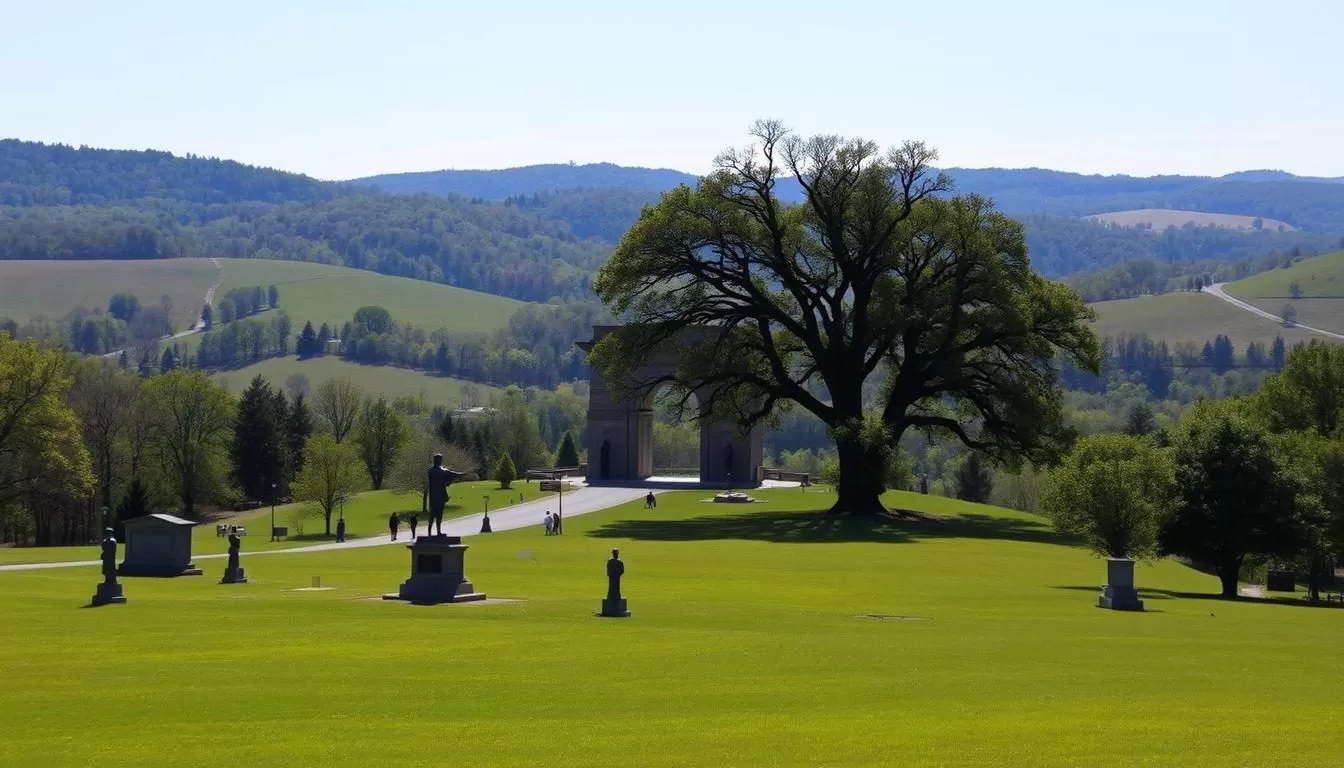✓ Accommodations✓ Flights✓ Rental Cars
Are you ready to explore a destination that seamlessly blends American history with modern entertainment? Valley Forge is a treasure trove of historical sites, family-friendly attractions, and exciting activities that cater to all ages and interests.
Imagine strolling through picturesque landscapes, visiting iconic historical landmarks, and enjoying a vibrant arts scene. This charming region offers a unique experience that combines education and recreation, making it an ideal getaway for anyone looking to make the most of their time.
From well-known attractions to hidden gems, our guide will help you navigate the top picks and insider tips to create an unforgettable experience in Valley Forge.
Discovering Valley Forge National Historical Park
As you step into Valley Forge National Historical Park, you’re walking in the footsteps of General Washington and his Continental Army. This significant historical site spans over 3,500 acres of rolling hills and is home to 20 miles of trails, offering a unique blend of history and natural beauty.
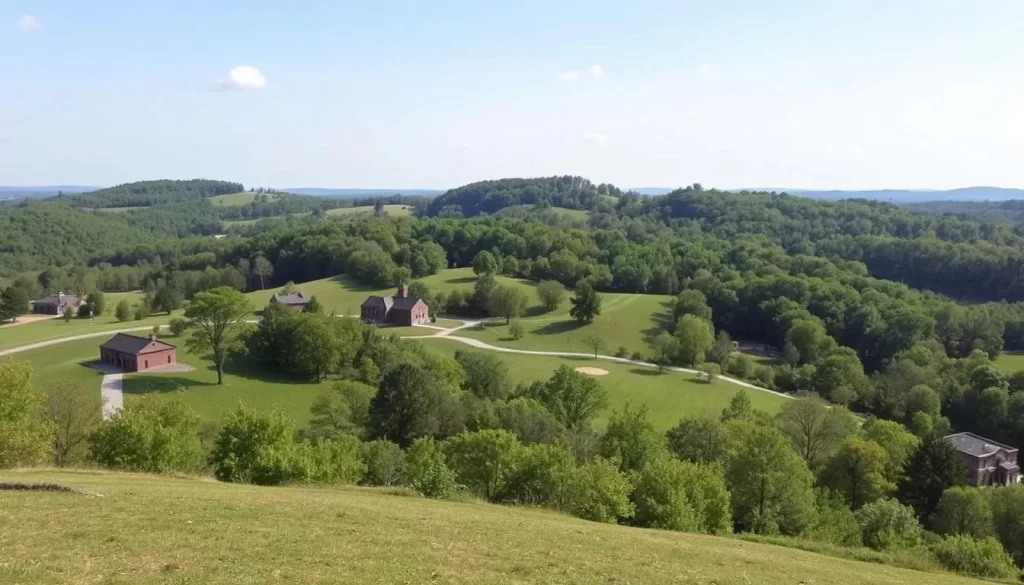
Washington’s Headquarters and Historic Sites
Explore the historical significance of Valley Forge National Historical Park as the winter encampment site of the Continental Army. Visit Washington’s Headquarters, a stone building that served as the command center during the Revolutionary War, and learn about the daily challenges faced by Washington and his officers.
National Memorial Arch
The iconic National Memorial Arch is a monument dedicated to the officers and soldiers of the Continental Army, symbolizing American perseverance. This impressive structure is a highlight of the park, honoring the sacrifices made during the Revolutionary War.
Reconstructed Log Huts
Experience history coming to life through the meticulously reconstructed log huts that show how soldiers lived during the harsh winter encampment. These reconstructions provide a glimpse into the daily lives of the soldiers who endured the challenging conditions at Valley Forge.
By visiting Valley Forge National Historical Park, you gain a deeper understanding of this crucial period in American history and appreciate the transformation of Valley Forge from a place of hardship to a symbol of American resilience.
Exploring the Park’s 30+ Miles of Trails
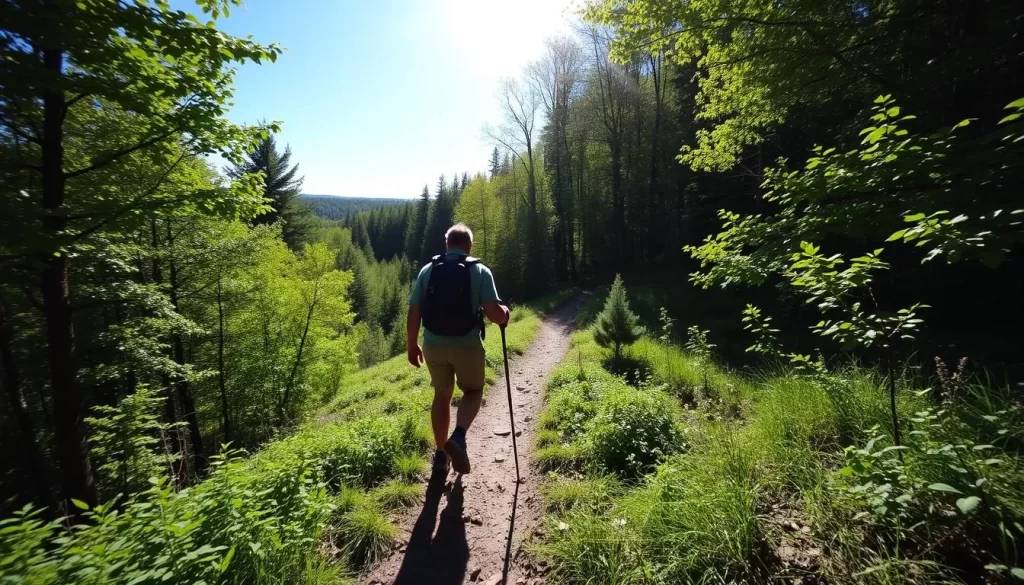
Explore the rich history and natural beauty of Valley Forge through its extensive trail network. With over 30 miles of trails, Valley Forge National Historical Park offers a unique opportunity to experience the park’s historical significance and natural beauty in one activity.
Best Hiking Routes for History Buffs
The Joseph Plumb Martin Trail, a 5-mile loop, is a must-visit for history enthusiasts. This trail connects many of the park’s key historical sites and features interpretive signage along the way, providing a rich historical context to your hike. You can follow in the footsteps of Revolutionary War soldiers while enjoying scenic views.
Biking Through Valley Forge
Valley Forge National Historical Park also offers paved multi-use trails perfect for casual cyclists and families. The trails accommodate different fitness levels, from easy walks to more challenging hikes with elevation changes. You can enjoy the scenic beauty of the park while getting some exercise.
The trail system is open to walkers, runners, and bikers, making it an ideal destination for outdoor enthusiasts. Be sure to check the seasonal trail conditions to plan your visit accordingly.
Ranger Programs and Educational Experiences
You can engage with the history of Valley Forge in a meaningful way through the park’s ranger programs and educational activities.
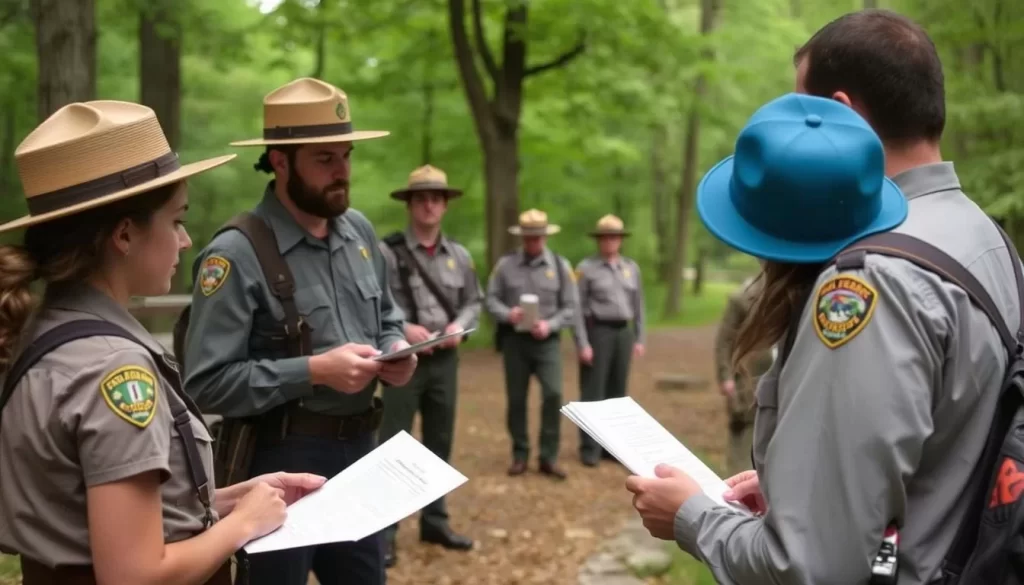
Becoming a Junior Ranger
The Junior Ranger program is a fun and educational experience designed for children. By participating in this program, kids can explore the park, learn about its history, and earn their official Junior Ranger badge.
Guided Tours and Demonstrations
Valley Forge National Historical Park offers various guided tours and living history demonstrations. These programs bring the history of the park to life through expert storytelling and demonstrations, covering topics such as military strategy, medical practices, and daily life during the Revolutionary War.
The park’s ranger programs provide a range of hands-on experiences and fascinating topics that engage the whole family with the stories of Valley Forge. Some of the activities include:
- Discovering the variety of ranger-led programs available throughout the year.
- Learning about the Junior Ranger program and its activities.
- Exploring different types of guided tours, including walking tours and thematic tours.
- Understanding how these educational programs help visitors connect with American history.
Family-Friendly Attractions Near Valley Forge
If you’re planning a trip to Valley Forge with your family, you’ll be pleased to know that there are plenty of attractions to enjoy together. Located just a short drive from Valley Forge National Historical Park, these destinations offer a great way to complement your historical exploration with some fun and entertainment.
Elmwood Park Zoo
The Elmwood Park Zoo is a top-rated family-friendly attraction where you can get up close with wildlife. Enjoy unique experiences like hand-feeding giraffes and bison or take a ride on the wildlife-themed carousel. It’s an ideal spot for families to create lasting memories.

Legoland Discovery Center
For a dose of LEGO fun, head over to the Legoland Discovery Center in Plymouth Meeting. Explore Miniland, an impressive LEGO replica of Philadelphia made from 1.5 million LEGO bricks. This interactive play area is sure to delight both kids and adults, providing an entertaining and educational experience.

Seasonal Outdoor Adventures at Spring Mountain
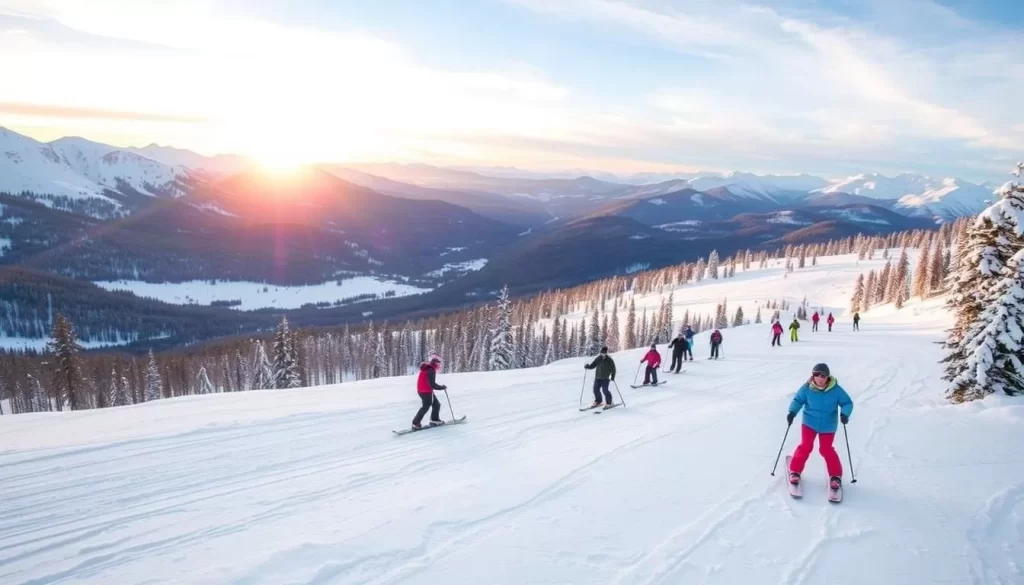
For those seeking adventure beyond Valley Forge’s historical sites, Spring Mountain is a great choice. Located near Valley Forge, Spring Mountain Adventures offers a range of seasonal activities that allow you to enjoy nature and the outdoors at any time.
Winter Activities
In the winter, Spring Mountain transforms into a winter wonderland, offering skiing, snowboarding, and snow tubing options perfect for both beginners and experienced winter sports enthusiasts. You can enjoy these activities with family and friends, making it a great attraction near Valley Forge.
Summer Fun Options
As summer arrives, the slopes of Spring Mountain become venues for hiking, mountain biking, canopy tours, and zip-lining adventures. This transformation offers a unique way to experience the nature around Valley Forge, providing a perfect complement to the historical experiences available in the area.
Journey Through Historic Sites in Montgomery County
Your journey through American history continues in Montgomery County, where numerous historic sites await your visit. As you explore the area around Valley Forge, you’ll discover a rich tapestry of historical attractions that provide a more comprehensive understanding of colonial Pennsylvania.
Pottsgrove Manor and Colonial History
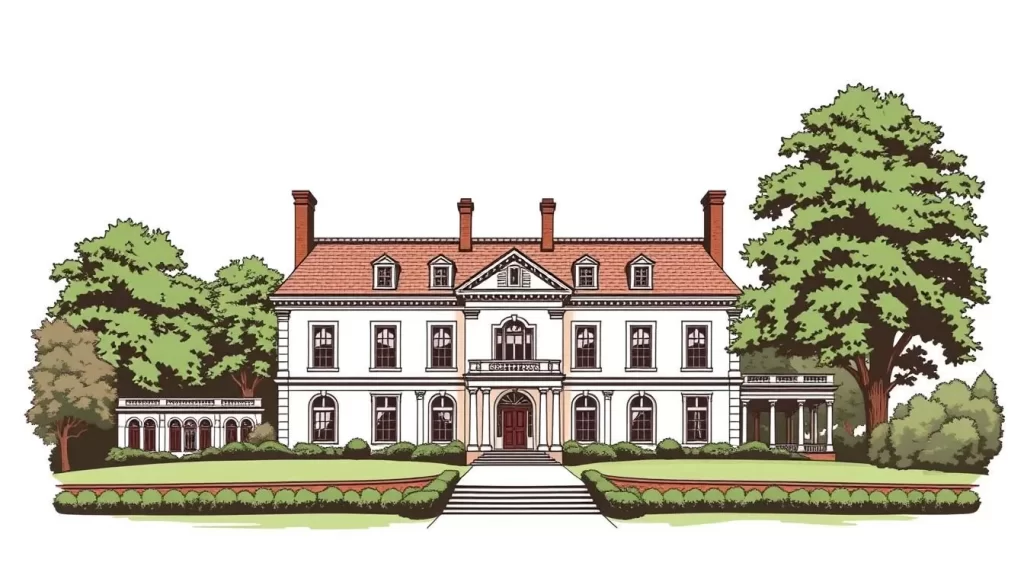
Pottsgrove Manor, built in 1752, is an elegant Georgian mansion that offers insights into colonial aristocratic life. With its preserved architecture, period furnishings, and educational exhibits, you can gain a deeper understanding of the history of the area.
Bryn Athyn Historic District
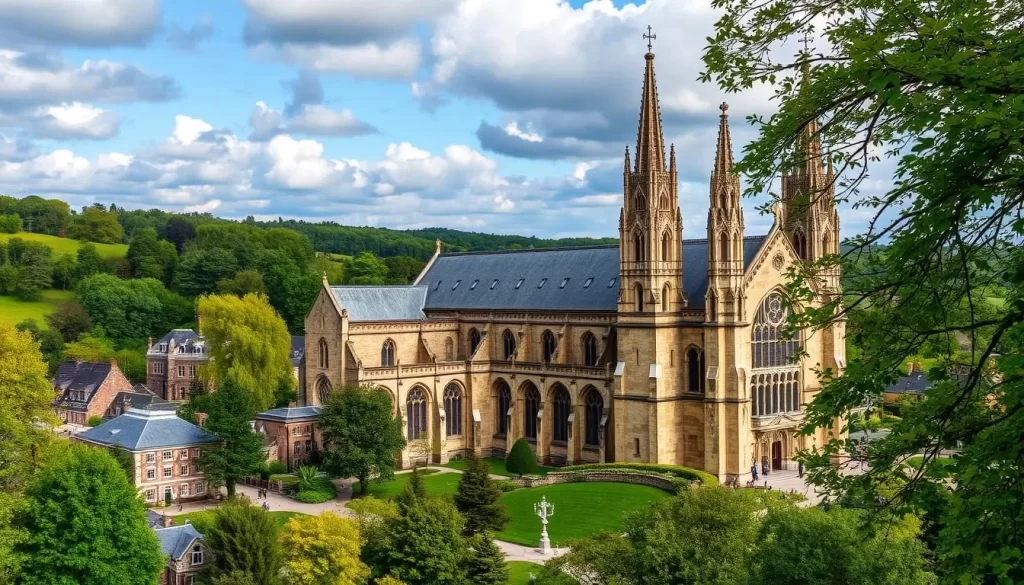
The Bryn Athyn Historic District is a must-visit, featuring the breathtaking Bryn Athyn Cathedral with its Gothic architecture, the castle-like Glencairn Museum, and beautifully maintained gardens. These attractions not only showcase the architectural significance of the period but also highlight the contributions of prominent families to local and national history.
By visiting these sites, you’ll gain a broader understanding of the Valley Forge experience and its connection to the broader narrative of American colonial history. With special tours, demonstrations of colonial crafts, and seasonal events, these historic properties come alive for visitors.
Valley Forge, Pennsylvania: Best Things to Do – Top Picks for History Lovers
Beyond the main attractions, Valley Forge and its surrounding areas are dotted with historical gems waiting to be discovered. History enthusiasts can enrich their visit by exploring these significant sites.
Historic Trappe Attractions
Historic Trappe is a small town with remarkable historical significance, featuring well-preserved sites like the Muhlenberg House, the Speaker’s House, and the historic Dewees Tavern. The Muhlenberg House, for instance, showcases the history of the Muhlenberg family, who played a crucial role in early American religious and political development.
Pennypacker Mills
Another historical site worth visiting is Pennypacker Mills, the colonial-era home of Pennsylvania Governor Samuel W. Pennypacker. This site features original furnishings and an impressive collection of historical artifacts, providing a glimpse into colonial life.
| Historic Site | Significance |
|---|---|
| Muhlenberg House | Showcases the history of the Muhlenberg family |
| Pennypacker Mills | Colonial-era home with original furnishings and artifacts |
| Dewees Tavern | Historic tavern from the colonial era |
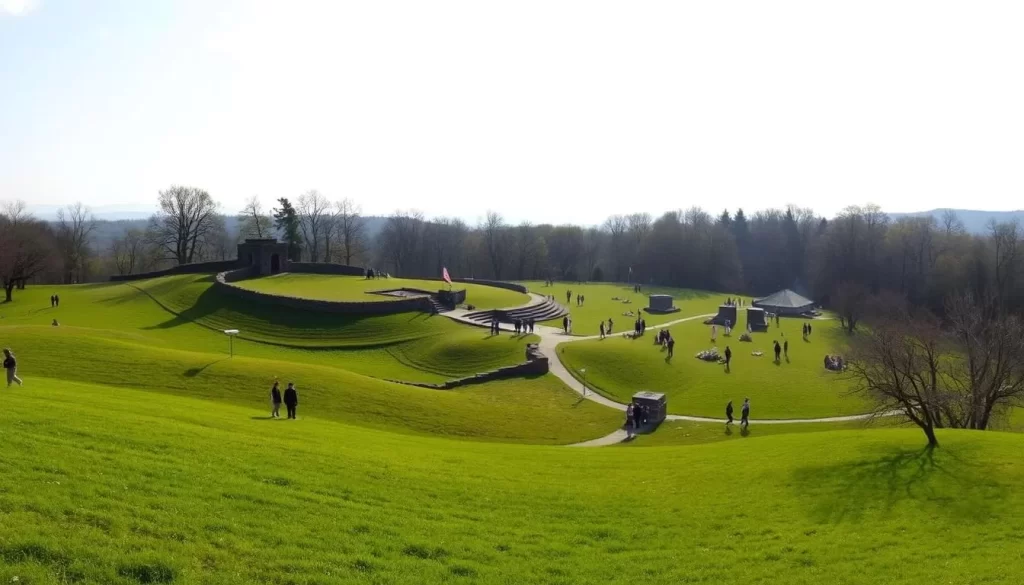
Outdoor Recreation Beyond the Park
The natural beauty of Montgomery County beckons you to explore beyond the Valley Forge National Historical Park. With almost 90 miles of hiking trails and numerous water activities, there’s something for every outdoor enthusiast.
Schuylkill River Water Activities
Discover the Schuylkill River’s water activities, including kayaking, canoeing, and paddleboarding. You can rent equipment or join guided tours to explore the river’s best sections.

Green Lane Park Adventures
Green Lane Park, a 3,400-acre park, offers a serene natural setting for fishing, boating, and pontoon boat tours on its reservoir. It’s an ideal spot to connect with nature and enjoy outdoor attractions.
These outdoor activities can be easily incorporated into your Valley Forge itinerary, creating a balanced vacation experience that combines history, education, and recreation in Valley Forge and its surrounding park areas, with plenty of trails to explore.
Arts and Culture Experiences
Beyond its historical significance, Valley Forge boasts a thriving arts scene. The area is home to numerous cultural institutions that offer a wide range of experiences.
Museums and Galleries
Montgomery County is home to a diverse array of museums and galleries. You can explore the Berman Museum of Art, which features an impressive collection, or visit the Mennonite Heritage Center to gain insights into the region’s cultural history.
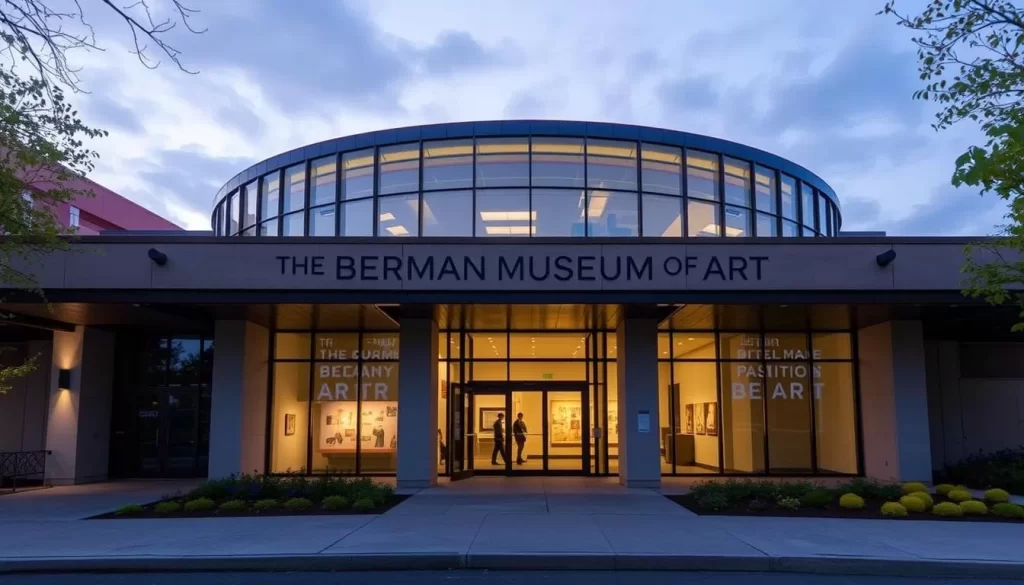
Theater and Performance Venues
The Valley Forge area is known for its vibrant theater scene, with venues like the award-winning Act II Playhouse presenting professional productions. You can enjoy classic plays, contemporary works, or even improv and comedy classes.
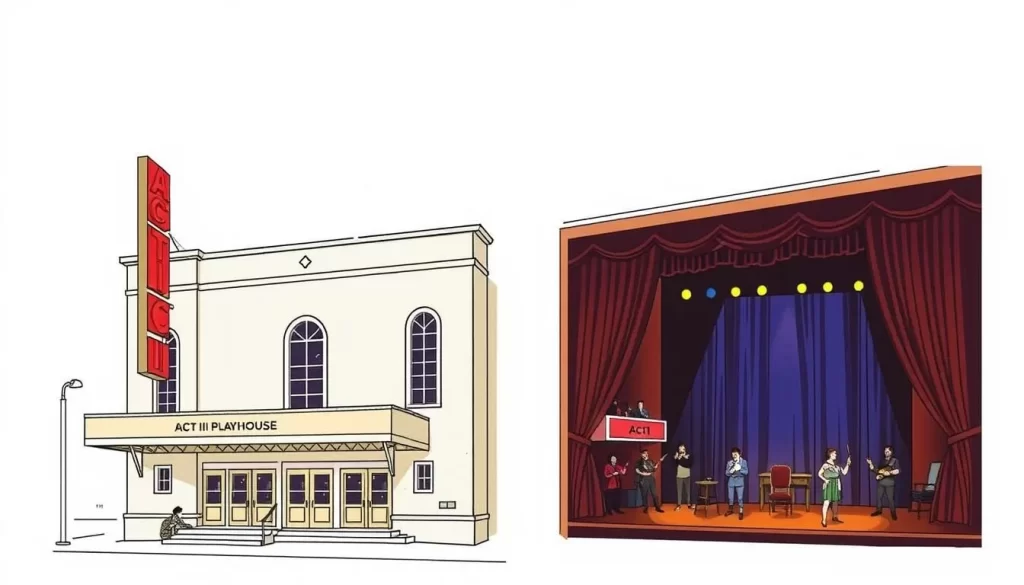
Shopping Destinations in Montgomery County
You’ll find exceptional shopping experiences in Montgomery County, from luxury malls to quaint downtown areas. Whether you’re looking for high-end brands or unique local finds, Montgomery County has something for everyone.
King of Prussia Mall

The King of Prussia Mall is one of the largest shopping destinations in the United States, boasting over 450 stores. This includes luxury retailers, department stores, and specialty shops, all under one roof. Visitors can enjoy a variety of dining options and special services, making it a must-visit destination for anyone in the Valley Forge area.
Charming Downtown Shopping Areas
For a more personalized shopping experience, the charming downtown areas of Ambler, Skippack, and Narberth offer unique boutiques, antique shops, and locally-owned stores. These areas reflect the character of their communities, providing products you won’t find in typical mall environments. Be sure to check out seasonal shopping events and farmers markets during your visit to King of Prussia.
Nightlife and Entertainment Options
Discover the diverse entertainment options available in Valley Forge for a memorable night out. Whether you’re interested in gaming, live music, or craft beverages, Valley Forge has something for everyone.
Enjoy a Night Out in Valley Forge by attending a live music performance, visiting local breweries and wineries, or trying your luck at the casino.
Valley Forge Casino Resort
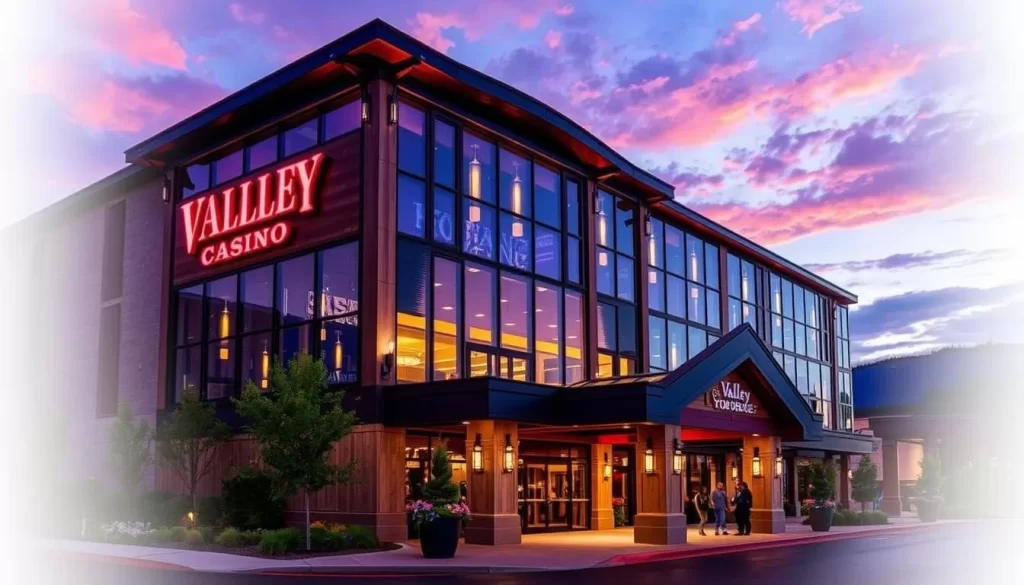
The Valley Forge Casino Resort offers a comprehensive entertainment experience, featuring slots, table games, and poker. With multiple dining options and live entertainment, it’s a great place to spend an evening.
Local Breweries and Wineries

Montgomery County is home to a thriving craft beverage scene, with numerous local breweries, wineries, and distilleries. Many of these venues offer tours, tastings, and unique atmospheres that incorporate local history and ingredients.
Golfing in Montgomery County

Golfers, rejoice! Montgomery County is home to numerous golf courses, including historic ones, that promise an unforgettable experience. With over 50 courses to choose from, you’re spoiled for choice.
Historic Golf Courses
Montgomery County boasts some of the most historic golf courses in the country, with some dating back to the early 20th century. These courses offer a unique blend of challenging play and beautiful landscapes.
Planning Your Golf Weekend
To make the most of your golfing trip, plan ahead by booking tee times and exploring golf packages that suit your needs. With many courses located near Valley Forge, you can enjoy a mix of golf and history.
Whether you’re a seasoned golfer or just starting out, Montgomery County has something for everyone. From championship layouts to more forgiving courses, you’ll find the perfect spot to enjoy your game.
Special Events and Seasonal Activities
Throughout the year, Valley Forge hosts various special events and seasonal activities that enhance your visit. These events bring additional dimensions to your experience, offering unique insights into history and the local culture.
Valley Forge Revolutionary5-Mile Run
The 19th Annual Valley Forge Revolutionary5-Mile Run is a highlight for outdoor enthusiasts. Participants can run or walk through the Valley Forge National Historical Park, or join virtually. Proceeds support the preservation of this historic site.
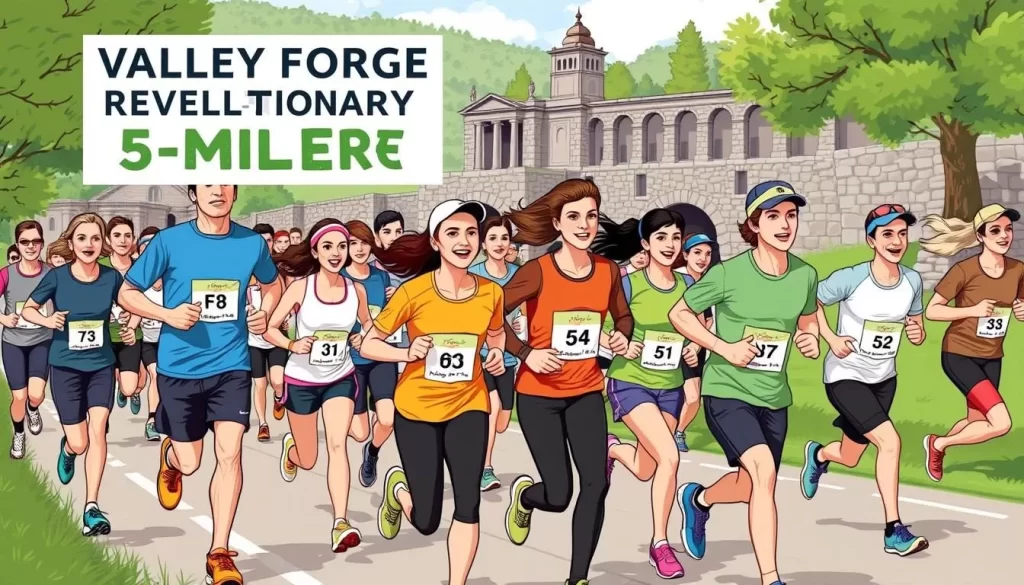
Colonial May Fair at Pottsgrove Manor
Experience colonial history at the Colonial May Fair hosted by Pottsgrove Manor. Enjoy traditional 18th-century dances, crafts, and the iconic maypole festivities. This event is a delightful way to engage with the region’s rich history.
Spring Activities in Valley Forge
Spring brings new life to Valley Forge, making it an ideal time to explore the area’s natural beauty and historical significance. As the season unfolds, the park transforms into a vibrant destination, offering a range of activities for visitors.
Cherry Blossom Viewing
Montgomery County’s cherry blossom trees reach their peak bloom from April 5 to April 8, 2025. Inner Line Drive at Valley Forge National Historical Park is a favorite spot to view these beautiful trees, along with other locations like Green Lane Park and the Harriton House in Bryn Mawr.
Trout Fishing Season
Southeast Pennsylvania’s trout fishing season begins on April 5th, offering anglers a chance to explore the county’s lakes and rivers. Popular spots include Deep Creek Lake in Green Lane Park and Valley Creek within Valley Forge National Historical Park, known for big brown trout.
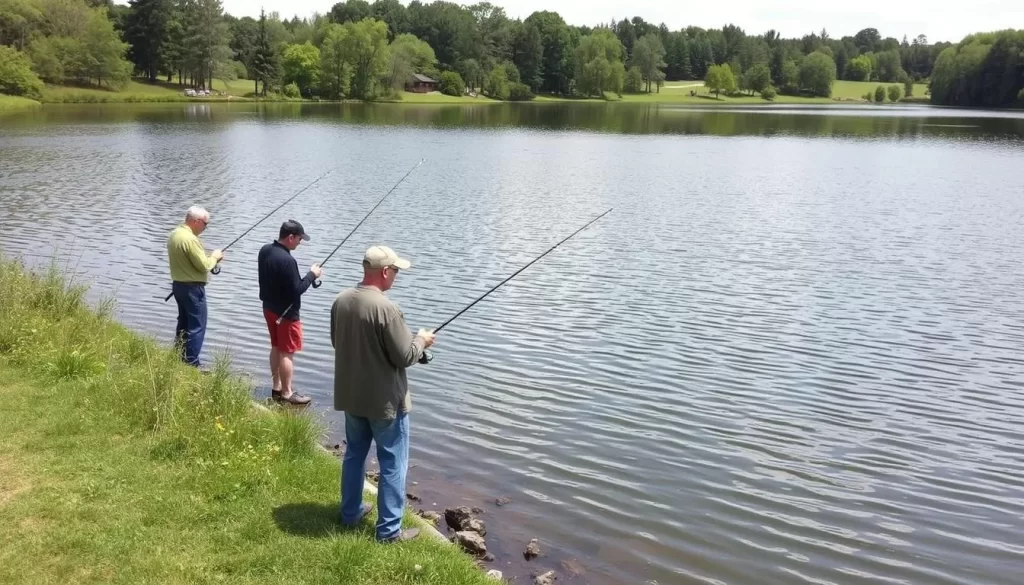
Where to Stay When Visiting Valley Forge
Your stay in Valley Forge can be as enriching as the experiences you have there, thanks to its varied lodging options. With so many things to discover here, you’ll never run out of experiences to enjoy during your stay!

Accommodations for History Enthusiasts
For those drawn to history, Valley Forge offers historically-themed accommodations that enhance your immersion in the area’s rich heritage. Historic inns and bed-and-breakfasts in restored colonial buildings provide a unique experience, allowing you to stay in the heart of history.
Family-Friendly Lodging Options
Families traveling with children can find suitable lodging options equipped with amenities like swimming pools, game rooms, and suite-style rooms. These family-friendly accommodations ensure a comfortable and enjoyable stay for all family members.
When visiting Valley Forge, you can explore diverse accommodation options that cater to different preferences, budgets, and travel styles. Hotels located near Valley Forge National Historical Park offer convenient access to main attractions while providing modern amenities and comforts. Understanding the benefits of staying in different areas around Valley Forge, from downtown locations near restaurants and shopping to quieter settings with scenic views, can help you make an informed decision. Additionally, some accommodations offer packages that include tickets to attractions, guided tours, or other perks that enhance your Valley Forge experience.
Conclusion: Making the Most of Your Valley Forge Visit
Whether you’re a history buff or an outdoor enthusiast, Valley Forge is a must-visit destination. With its rich historical significance, diverse attractions, and natural beauty, you’ll never run out of experiences to enjoy during your stay.
To maximize your visit, balance historical exploration with recreational activities like hiking the park’s 30+ miles of trails or visiting the nearby Elmwood Park Zoo. Check the official Valley Forge National Historical Park website for updated information on hours, programs, and special events throughout the calendar year.
By incorporating day trips to nearby attractions in Philadelphia and the surrounding countryside, you can extend your stay and enhance your travel experience. With so much to discover, Valley Forge offers something for everyone, making it an unforgettable destination.
The above is subject to change.
Check back often to TRAVEL.COM for the latest travel tips and deals.
